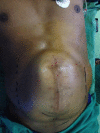Component Separation Technique: an Effective Way of Treating Large Ventral Hernia
- PMID: 27011605
- PMCID: PMC4775582
- DOI: 10.1007/s12262-015-1265-0
Component Separation Technique: an Effective Way of Treating Large Ventral Hernia
Abstract
Repair of large ventral hernia is a challenge for even experienced surgeons, as there are large defects with large contents, often with loss of domain. The large defects were bridged by various plastic surgical procedures like myofascial flaps or free flaps with high recurrences and complications. More often, the bridging was done with artificial prosthesis, leaving the defects open. This was accomplished by either open surgery (onlay, inlay, sublay or underlay) or laparoscopic intraperitoneal onlay meshes (IPOMs). However, non-closure of the midline had adverse effects on postural maintenance, respiration, micturition, defecation and biomechanical properties, which have a profound impact on the patients' overall physical capacity and quality of life. Component separation technique (CST) is a novel answer to the closure of midline with live, active tissues with or without the use of additional prosthesis. Though this technique was originally described in 1990, it has undergone lots of modifications like perforator preserving CST, endoscopic technique and posterior component separation. So, we present a series of 22 patients with large ventral hernia repaired using various options of component separation technique in the last 3 years.
Keywords: Component separation technique; Large ventral hernia; Posterior component separation; Ventral hernia.
Figures
Similar articles
-
Quality of Life after Ventral Hernia Repair with Endoscopic Component Separation Technique.Scand J Surg. 2016 Mar;105(1):11-6. doi: 10.1177/1457496915571402. Epub 2015 Feb 13. Scand J Surg. 2016. PMID: 25681058
-
Preliminary experience and development of an algorithm for the optimal use of the laparoscopic component separation technique for myofascial advancement during ventral incisional hernia repair.J Laparoendosc Adv Surg Tech A. 2011 Jun;21(5):405-10. doi: 10.1089/lap.2010.0490. Epub 2011 Apr 27. J Laparoendosc Adv Surg Tech A. 2011. PMID: 21524200
-
A case series of laparoscopic components separation and rectus medialization with laparoscopic ventral hernia repair.J Laparoendosc Adv Surg Tech A. 2009 Oct;19(5):607-10. doi: 10.1089/lap.2009.0155. J Laparoendosc Adv Surg Tech A. 2009. PMID: 19694565
-
Open ventral hernia repair with component separation.Surg Clin North Am. 2013 Oct;93(5):1111-33. doi: 10.1016/j.suc.2013.06.010. Epub 2013 Jul 25. Surg Clin North Am. 2013. PMID: 24035078 Review.
-
[Component separation for closing large abdominal wall defects: evolution of a method from 1990 to present day].Zentralbl Chir. 2015 Apr;140(2):186-92. doi: 10.1055/s-0034-1368378. Epub 2014 Apr 25. Zentralbl Chir. 2015. PMID: 24771219 Review. German.
Cited by
-
An early experience with transversus abdominis release for complex ventral hernias: a retrospective review of 100 cases.Hernia. 2021 Apr;25(2):353-364. doi: 10.1007/s10029-020-02202-w. Epub 2020 May 6. Hernia. 2021. PMID: 32377962
-
Posterior component separation with TAR: lessons learned from our first consecutive 52 cases.Updates Surg. 2023 Apr;75(3):723-733. doi: 10.1007/s13304-022-01418-y. Epub 2022 Nov 10. Updates Surg. 2023. PMID: 36355329
-
Retrospective analysis of defect reconstruction after abdominal wall tumor resection in 30 patients.Hernia. 2021 Apr;25(2):375-381. doi: 10.1007/s10029-020-02219-1. Epub 2020 May 25. Hernia. 2021. PMID: 32451791
-
What Exactly is Meant by "Loss of Domain" for Ventral Hernia? Systematic Review of Definitions.World J Surg. 2019 Feb;43(2):396-404. doi: 10.1007/s00268-018-4783-7. World J Surg. 2019. PMID: 30187090 Free PMC article.
-
IPOM versus eTEP as minimally invasive approaches for ventral/incisional hernias: a systematic review and meta-analysis.Hernia. 2025 Apr 14;29(1):144. doi: 10.1007/s10029-025-03319-6. Hernia. 2025. PMID: 40227366 Free PMC article.
References
-
- Novitsky YW, Elliott HL, Orenstein SB, Rosen M. Transversus abdominis muscle release: a novel approach to posterior component separation during complex abdominal wall reconstruction. JAM J Surg Nov. 2012;204(5):709–716. - PubMed
LinkOut - more resources
Full Text Sources
Other Literature Sources



